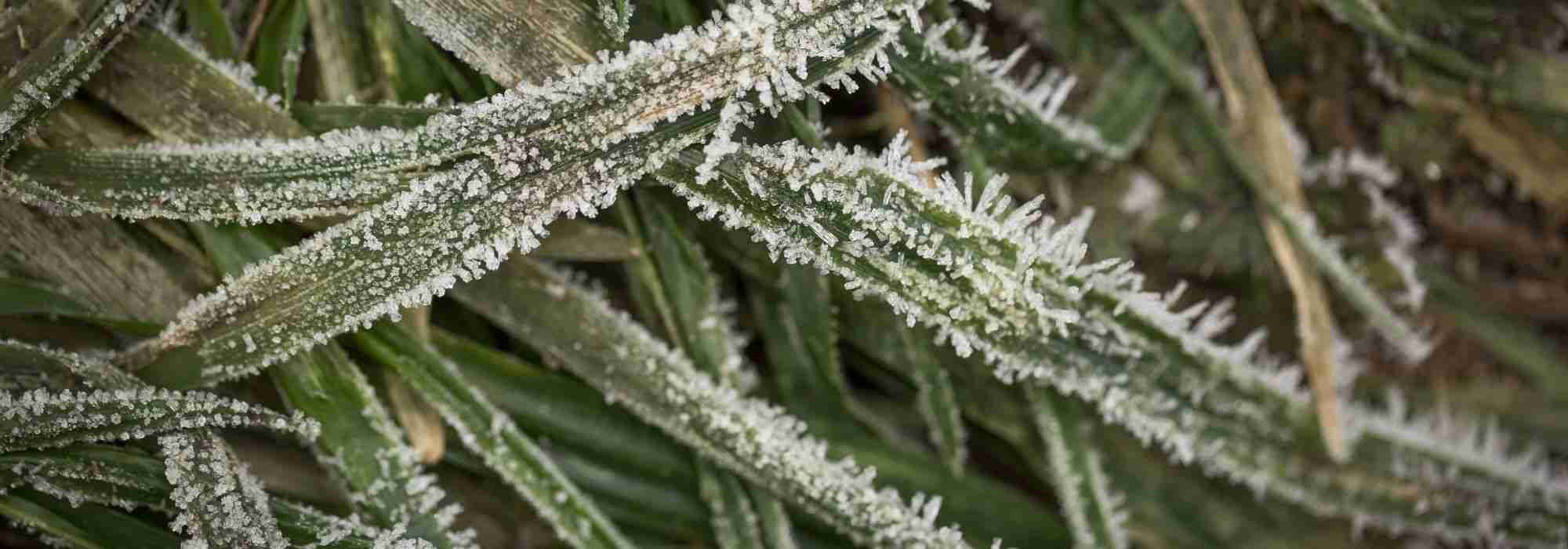
Preparing your garden for winter
Key steps before the cold sets in
Contents
As autumn rains return, garden is recovering from heat of recent months. Many plants have regained their splendour, and flowering, scents and fruits still punctuate it. Trees have donned their finest late-season colours, enhanced by October and November light. But all these beauties must not make you forget that winter is coming, bringing with it a host of dangers for garden: frost, wind, stagnant moisture… Your little paradise, whether garden, terrace or balcony, deserves care so it can get through this season without risk.
I therefore suggest following these simple actions and tips to prepare your garden for winter.
→ Also find our tips in our audio podcast :
Short grass meadow and lawn: tidy and mow before cold sets in
After enduring summer heat, autumn rains have helped your lawn regain strength to face the coming cold season. As winter approaches, short grass meadow stops growing.
- Before cold and frost set in, carry out a final mow, fairly high, around 4 cm.
- At this time, it is not uncommon for the soil to be covered with a tapetum of dead leaves. In dry weather, leaves can easily be shredded and sucked up by the mower. If weather is damp, they are too heavy, packed on top of one another: better to gather them with a leaf rake. In any case, do not leave them on the soil for too long as they deprive herb of light and air and can then give way to naked patches, very unsightly. Discover how to make use of this resource in Ingrid’s article: Dead leaves, how to use them in the garden?
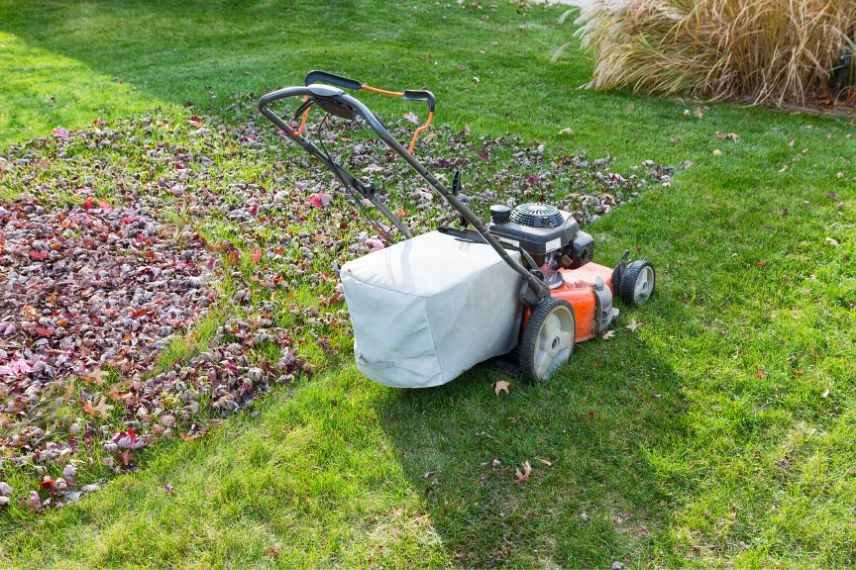
Beds and borders: weeding, amending and mulching
Borders, which are gradually thinning, can look a little untidy and unsightly.
- Carry out weeding of borders. Pull out unwanted weeds, favouring manual and natural methods.
- Lightly rake the soil, then spread a natural soil amendment. Discover all the benefits of natural soil fertilisation.
- Spread a generous layer of mulch over the whole border, about 10 centimetres thick. Fallen leaves, straw, BRF (ramial chipped wood), pine bark (for acidophilous plants such as rhododendrons) or a commercial natural mulch all work very well. This cover insulates the soil from cold and also reduces surface crusting and leaching caused by winter rains. Read Michael’s advice explaining when and why to mulch.
My advice: don’t delay weeding too long — the closer you get to winter, the more likely you are to be hindered and to damage early-flowering bulbs (crocuses, grape hyacinths, daffodils…), which can begin their growth quite quickly at the end of the year if planted the previous year.
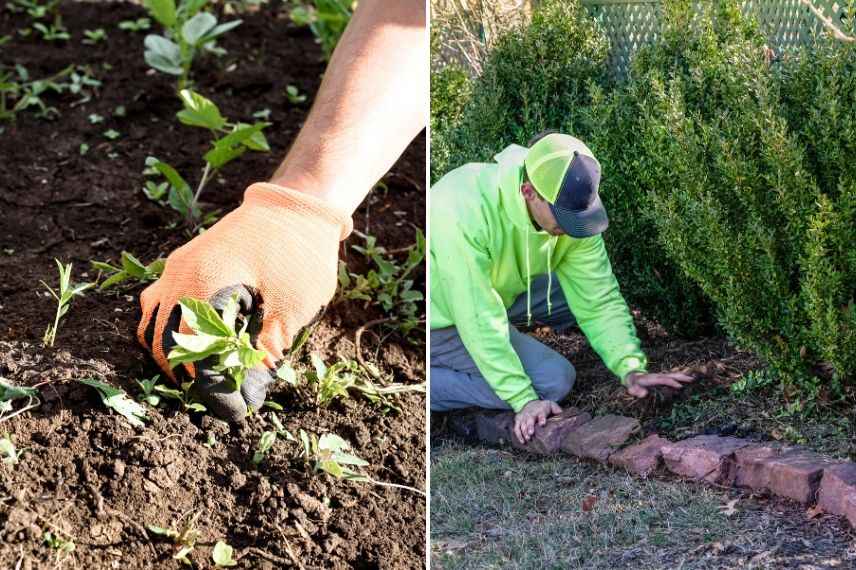
Weed, amend and mulch!
Perennials, roses, annuals: clean, protect and overwinter
Not all plants in your garden have same degree of hardiness. Some can face winter without flinching, while others need specific care. Bear in mind that duration of frost, wind, exposure and nature of your soil are all factors to consider when assessing a plant’s hardiness. Consult Élisabeth’s article that explains everything you need to know about plant hardiness. Ingrid also gives all methods and tips to protect plants from cold and frost in winter.
Bushes left in open ground
- Check that roots are protected by a thick mulch.
- If severe cold is forecast, wrap aerial parts in a frost fleece, ensuring air circulates between leaves and this cover. Making a wooden frame allows the fleece to be stretched without touching green parts. You can also reinforce this protection by adding dead leaves. Remember to remove the fleece during thaw (when temperatures rise above freezing).
- Roses can be lightly pruned, by about one-third of their height, and their base banked up until spring: bring soil up around base to form a small mound that then protects graft. Late-season pruning is a wide topic and approaches vary. To form your own view, read Virginie’s humorous article on pruning roses at end of season.
Perennials and annuals at end of season
- Pull up spent annuals, which can then remain on soil or be added to compost heap.
- Leaving faded or dried perennials in place offers several advantages! Some retain attractive presence in winter, whether by their habit, their faded inflorescences or their fruit, and when frost highlights their form the scenes thus created can be superb. Moreover, they provide shelter and food for a wide variety of wildlife. Finally, their aerial parts protect plant crown and contribute to development of a microclimate within the border. Each, on its scale, creates a windbreak for neighbours, therefore softening bite of cold. I therefore recommend leaving them in place, except those that have lost all aesthetic interest or collapse without any shape.
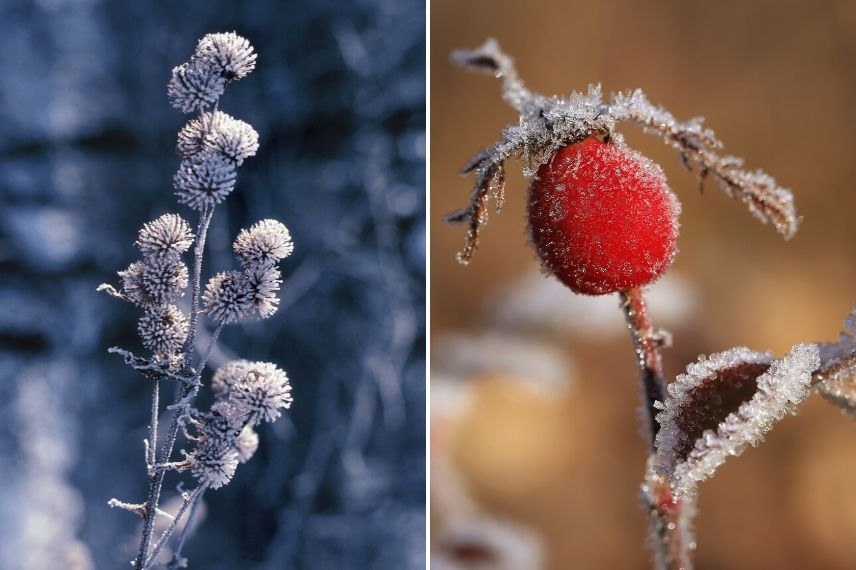
Withered flowers and frosted decorative fruits
Potted plants: protect or shelter in frost-free place
Your potted plants are more sensitive to cold than those in ground. Their roots are more exposed (air and wind cool container walls, chill of soil).
- If you leave them outdoors, move them closer to most sheltered areas (wall, sunny evergreen hedge…). Turn saucers over before placing container on them again. You can also simply raise pot using small blocks. Mulch surface of pot and install a frost fleece if particularly severe cold is forecast, removing fleece as soon as thermometer returns to positive temperatures.
- Some plants cannot withstand sub-zero temperatures. These frost-tender plants must be brought indoors to a frost-free shelter (unheated greenhouse, garage…). Although watering is less frequent in winter, you will still need to check that substrate does not dry out completely.
→ For everything on overwintering potted plants, read Ingrid’s article on the subject.
What to do with frost-sensitive bulbs in winter?
Some bulbs tolerate remaining in ground year-round very well, and cold is even necessary to pace their growth cycle and trigger restart in spring. Others, however (Dahlias, Cannas…) may not survive winter, depending on severity of cold, its duration and nature of your soil. If you are unsure whether to lift them for storage or leave them in ground, follow Ingrid’s advice in her article: Overwintering Dahlias — should they be lifted?
Ponds and fish: single steps for a serene winter
The pond also shelters flora and fauna that can suffer from winter rigours. A few precautions should therefore be taken :
- Remove the last leaves and debris that have fallen into the water, before they sink to the bottom and rot. Their presence can cause sanitary problems, promote algae growth and, over time, create silt at the bottom of the pond, all the more problematic if the pond is lined with a liner.
- Prune and clean the plants in the pond and on its banks, just as you would those growing in your borders.
- Most aquatic plants can withstand winter, provided their stump is not frozen and they are growing in a pond of sufficient size. Be careful, however, with Thalias, exotic water lilies and papyrus, which are more sensitive to cold. It is uncommon here for water to freeze by more than a few centimetres, but as a precaution, make sure plants growing in baskets are covered by around 50 cm of water. For mini-ponds, like those shown by Olivier, if you live in a cold area it is better to overwinter your plants in a bucket of water kept frost-free. For floating plants, such as water lettuce or water hyacinth, you can try to keep them by placing them on the surface of a container filled with water and kept at about 15°C, but success is unpredictable.
- If your pond houses fish (Koi carp, goldfish, Shubunkins…), you should have fed them food richer in protein and fat in autumn and, in any case, gradually stop feeding them at the start of winter.
- Remove pumps and filters, clean them and store them where they will be protected from frost, either by placing them back into the pond at a sufficient depth so they are not trapped by ice, or by immersing them in a bucket of water kept in a frost-free location.
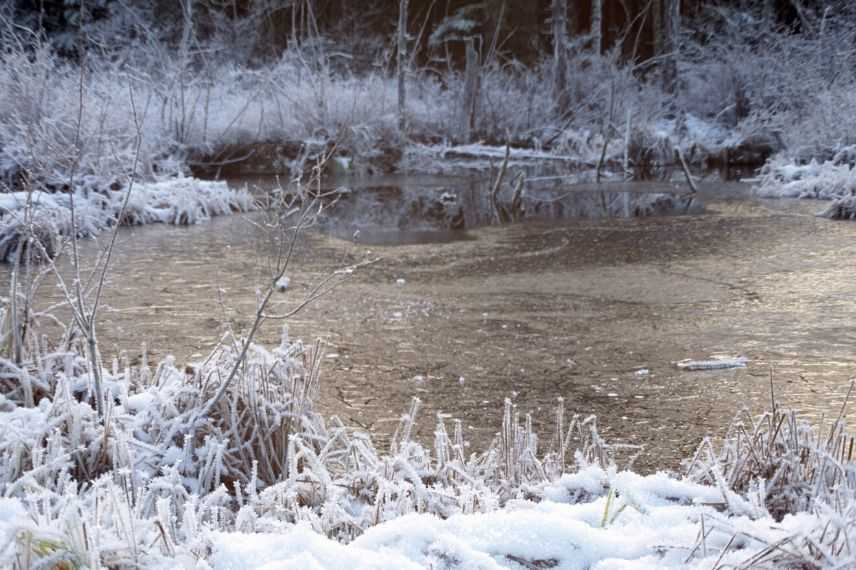
Pond frozen in winter
Watering systems: preventing frost damage
All infrastructure and equipment used to water the garden can suffer serious damage from frost. Taking the right steps before the cold really sets in will protect you from unpleasant surprises that often only become apparent when it’s too late, namely at the thaw.
- Close the supply tap and open the end of your hosepipe to drain all water. Then store everything in a shed for winter.
- If you can isolate the circuit upstream, also drain the pipes by leaving taps open until water stops flowing. Otherwise, wrap external pipes and taps with cardboard or bubble wrap, for example. Cover everything with plastic to shelter your system from the rain.
- Drain your automatic irrigation system, dismantle the various pipes and drippers, and soak them in lukewarm water mixed with vinegar, then rinse them before coiling and storing them in a shed.
- Dismantle the controllers and clean them in the same way, remove the batteries and store them as well.
Also to do when winter arrives
Finally, a few more little things to do :
- Empty fuel tanks of petrol-powered equipment you will no longer use (lawnmower, brushcutter, chainsaw…) and store them under cover. Now is also a good time to carry out maintenance (sharpening, cleaning spark plugs…). If you leave this task to a professional, don’t wait until spring as waiting times can be long.
- With plants going dormant, stop applying fertiliser well in advance to avoid encouraging new soft growth that would be very vulnerable to cold.
- Put out food and water to help birds through this season when resources are scarce. For more on this, discover all Virginie’s tips in her article : Feeding birds in winter.
With your garden thus ready for winter, all that’s left is to settle comfortably into an armchair by the fireside to read a good book… about gardens, of course → If you still miss your garden, don’t worry! I offer a whole range of gardening tasks to continue during winter!
- Subscribe!
- Contents
































Comments